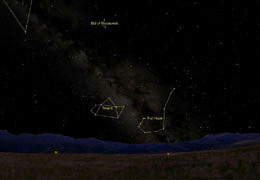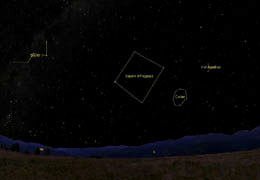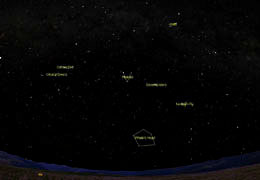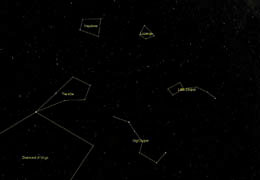|
For the constellations viewable from the
northern
hemisphere, shapes within constellations have been
commonly used. These are called Asterisms, and have
been used by many as alternate names to some of the
more popular constellations. A perfect example is
the Little Dipper and the Big Dipper. These are
Asterisms of Ursa Minor and Ursa Major. The Dippers
represent the body and tail of both bears. Below is
an example of some of the more popular Asterisms:
| For the first three Asterisms, we have
the Teapot (within Sagittarius), the Fish
Hook (within Scorpius), and the Bull of
Poniatowski (within Ophiuchus). |
 |
| This image shows four more Asterisms:
The W (Cassiopeia), the Square of Pegasus
(within Pegasus), the Circlet (within
Pisces), and Y of Aquarius (within
Aquarius). |
 |
| Here are seven more: Orion's Belt and
Orion's sword are a part of Orion, Hyades is
within Taurus, Whale's Head is a part of
Cetus, the Seven Sisters is actually an open
star cluster (the Pleades), Kids are a part
of Auriga and the Northern Fly is a part of
Ares. |
 |
| Here are five more: the Big Dipper is a
part of Ursa Major, the Diamond of Virgo
connects Virgo to Coma Berenices, Canes
Venatici, and Bootes. The Sail is Corvus,
the Sickle is a part of Leo, and Asses and
the Manger is a part of Cancer. |
 |
| Here is another four: the Little Dipper
is within Ursa Minor, the Keystone is a part
of Hercules, the Kite is a part of Bootes,
and the Lozenge is a part of Draco. |
 |
| Few
southern hemisphere stars have
asterisms. The ones that do are also visible
from the more southern parts of the northern
hemisphere. The False Cross is not a part of
a constellation, and the Southern Cross is
another name for Crux. The Three Patriarchs
is also known as Triangulum Australe. The
Southern Pointers point to the South Pole. |
 |
Back to Top
|

